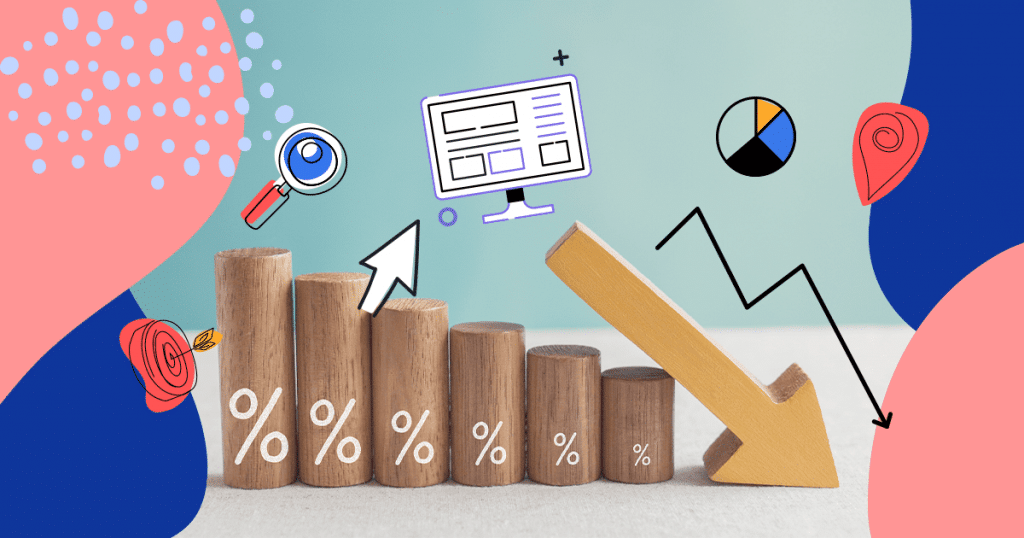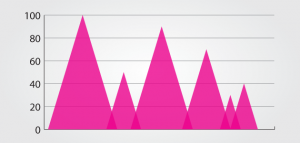With so many companies fighting for visibility online, engagement is always the best path to success.
But what if you are getting a lot of visitors and they just leave without interacting with anything?
A strategy to reduce bounce rate is a great way to make the most out of the traffic you are getting online — and guide more of your Digital Marketing leads towards conversion.
To help you with that, we prepared a special article, showing everything you need to know to start:
Download this post by entering your email below
What is Bounce Rate?
To better understand what bounce rate is, we can use a simple example. Start by imagining you have a physical store on a busy avenue.
There are a lot of people passing by your front doors every day. Some of them look at the products from the outside and show some interest. And a percentage of those feel compelled enough to go in.
But something feels off. A high number of those visitors stop right outside the doors, look around, make a funny face, and leave.
Why?
That is the central question of a strategy to reduce the bounce rate. This indicator shows you the percentage of total visits leaving your website without visiting other pages or immediately after entering.
In that sense, it shows how many leads feel engaged enough to get closer to your brand, but for some reason, not to the point of interacting and consuming anything from you.
Mastering this KPI on a company’s website (especially when it leads to conversions to online stores and digital products) should be one of the key goals in a Digital Marketing plan.
Why Reduce the Bounce Rate?
As it became clear in the previous topic, bouncing visitors are a lost opportunity. They are visitors who took the long digital journey to your website and then left without any interaction.
When we talk about Digital Marketing, engagement is way more important than raw numbers. It doesn’t matter if you have a million visits every day if they don’t lead to a single conversion.
The bounce rate is important because optimization is important. The companies leading the digital field aren’t necessarily the ones with more money to invest, but those who can convert as much as possible in relation to their budget.
When you can give that impeccable first impression, you make them stay. These users feel the need to explore your website, your content, and your brand. And each new page they visit is a step closer to a conversion.
Not only that, but you have more time to make them familiar. Users that stay on your site longer are more prone to come back regularly. They make a habit of it, which leads to sales, brand awareness, and loyalty.
A good strategy to reduce the bounce rate can make a business improve conversion rates with the same digital plan and budget they already have. It is a quicker, simpler way to expand your reach.
What is a Good Bounce Rate?
There’s no ideal number that literally every business out there should be shooting for when looking to reduce bounce rate.
One company might be perfectly happy with a bounce rate of 75 percent, while another would understandably find it horrific.
The difference depends on what your business goals are, as well as your industry and niche.
However, if you’re looking for a ballpark figure to start with, a bounce rate of around 70-80 percent is cause for concern unless there’s a very good reason for it.
Between 50 and 70 percent is about average. And if you’re between 30 and 50 percent, your bounce rate is considered excellent.
What’s considered a good or bad bounce rate can vary from one type of website or landing page to another, as well.
For example, with simple landing pages that carry a single call-to-action, a bounce rate of up to 90 percent is considered average.
Meanwhile, 10-30 percent would be closer to the average for a service site, portal, or similar.
You can find bounce rate numbers on your analytics tool:

18 Tips to Reduce Bounce Rate in Your Website
With all those points discussed, we can say for sure that an effort to reduce the bounce rate is beneficial in any circumstance and should be green-lighted as soon as possible.
But what can you and your team do to improve those numbers?
We listed 18 tips that will make a difference and help you engage more with the visitors you already have. Check it out.
1. Try to understand why visitors are leaving so early
Let’s go back to our example at the beginning of the article.
You have people entering your store, looking around, and leaving. What is your first question? You should be asking yourself what scared them away.
Was it the store’s layout? Was there a dissonance between the expectation they build and what they found inside? Were the offers off? Maybe the people you are attracting are not the ones interested in your brand?
Each answer you find will give a better insight into what you have to do to improve the bounce rate. This is why it is important to know your buyer persona and use it to build your strategy around it.
2. Design a better user experience
All the questions above should lead your team to find elements, tools, and processes that improve your site’s experience.
A good UX starts with a fast and well-structured website, but it goes way beyond that. It is the sum of visual elements, information, and interaction that meets certain expectations and exceeds them.
Again, use your buyer persona as a reference. What do they want when they enter your site? What are they looking for? How can you lead them and even surprise them in positive ways?
Maybe a rework of your pages is what you need to be more engaging.
3. Make sure your website is responsive
With evolving technology, there is an expanding variety of screen sizes, input methods, and device capabilities accessing your website.
A lot of bounce events happen when a user enters your site but can’t easily navigate, or visualize some of the information.
A responsive site is developed to adapt to any of those variants — making sure you don’t lose views for a simple problem like that.
4. Include a clear call-to-action
When looking to reduce bounce rate, you want to avoid doing anything to confuse your visitors. This includes overcomplicating your call-to-action (CTA).
For example, you should definitely avoid cluttering your landing pages with multiple CTAs. Decide on just one decisive action you want visitors to take, make it very clear, and make it honest.
You should also carefully consider the placement of your CTA.
The vast majority of your visitors will decide whether they like your site within seconds of landing on it, meaning they’re simply going to glance at the upper area of the landing page.
Consider placing your CTA within this area, so users know your page objective right up front.
5. Check the readability of your text
Modern web users have a lot of different options to choose from.
If your content isn’t easy to read and understand, it won’t matter how well it answers visitors’ questions. They won’t hesitate to find what they need somewhere else, and your bounce rate will soar.
You can reduce bounce rate by using bigger fonts, so your content is easy to read on smaller mobile screens, as well as breaking up your written content into snackable chunks, so it’s easy to skim.
You can do this with headings, bullet lists, and even creative elements like pictures, graphs, or charts.
Ensure your texts’ readability and SEO optimization by working with our freelance content creators. Get in touch with over 15,000 writers today at the WriterAccess marketplace. Try it for free!
6. Build some landing pages
One challenge companies stumble upon when working to reduce bounce rates, is predicting the entry points to your site.
It doesn’t matter how perfect your home page is if most traffic comes from a blog article that wasn’t optimized for engagement.
Landing pages are a great solution for that. They are specifically designed to serve as the optimal entry point — with compelling layouts and CTAs.
Think about the opportunities you have to create more of them and how you can adapt your marketing strategy to lead your traffic.
7. Rethink your product pages
If you run an eCommerce site and are looking to reduce bounce rate, you’ll want to look into ways to improve your product pages.
Sometimes a potential customer might bounce from a product page because they’re averse to a price point or perhaps aren’t truly ready to purchase at that time.
But other times, it’s because the page doesn’t have enough information on it for them to know whether or not this is the right product for them.
So think about whether your pages are missing key details that might help a customer convert.
Examples to consider include specs related to the product itself, info on your return policy, or user reviews and ratings.
8. Do some A/B testing
When you still have doubts about what kind of decisions will improve UX and bounce rate, why not test them?
An A/B is a test where you create two different versions of the same page and set them to appear to different visitors as they arrive.
Then you can measure which performed better in retaining traffic. You can consolidate the winner or go from it to another A/B, constantly improving your numbers.
9. Attract the right visitors
Think about the last time you were looking for something specific on a website you landed on via a SERP but couldn’t actually find it.
What did you do? If you’re like most people, you probably spent a small amount of time looking around before simply going somewhere else.
This is what happens every time any website (including yours) attracts a visitor who isn’t a fit for its content.
Make sure you’re attracting the audience who’s actually out there looking for your content and products.
Generate multiple landing pages, fill them with fantastic unique content your target audience will love, and optimize it for relevant keywords.
Ensure SERP listings are as attractive as possible with well-written meta descriptions. Work on making sure your online advertising campaigns are targeting the right people, as well.
10. Use visuals to captivate quicker
We, humans, are visual beings.
Having images and photos that are attractive and easily interpreted can grab the lead’s attention way quicker than any text — sometimes even catchy CTAs.
Invest more in visual elements and tie them to the next steps you want your customer to take.
You can make a page truly engaging, rather than one that just receives a passing glance — of course, as long as it makes sense and resonates with your audience.
11. Engage your audience with videos
Anything you can do to help capture a visitor’s attention quickly will help you reduce bounce rate significantly, and no medium does this better than video.
Not only is video more engaging than even the snappiest text and still imagery, but it’s also super-popular right now.
So look for ways to incorporate video into your pages to improve dwell time and keep your bounce rate low.
You can create an original video presentation relevant to your content or embed existing video from an outside source.
You can even use video as a full-screen background to enchant users and grab their attention, so don’t be afraid to think outside the box.
12. Keep your blog full of fresh content
The quality of your content can really make or break a visitor’s experience, so it’s essential to make sure yours is up to snuff.
Everything you post should be clear, engaging, and relevant to your target audience’s needs. Always opt for meaty, helpful content — no clickbait allowed!
And you’ll want to keep your website’s blog fresh via a steady stream of high-quality content.
Plan a content production strategy, and stick to it no matter what.
Keep your users’ experience exciting by leveraging multiple media formats (like video, slideshows, or infographics) and mixing things up in the subject matter department.
13. Plan your content marketing better
Content is always a great way of keeping people on your site.
Useful articles, rich materials, and relevant data will always be worth a longer, more meaningful contact with your brand.
But the pieces themselves aren’t enough. The audience could find it awesome but still leave.
So it is time to really invest in Content Marketing, with a connection between subjects, a better SEO effort, and a consistent link-building strategy.
14. Optimize your internal linking structure
A solid, streamlined internal linking structure is key to keeping your visitors engaged enough to stick around for a while.
However, it’s essential to realize that this doesn’t mean stuffing your content with as many links as possible.
Not only does this look terrible and hurt readability, but you run the risk of confusing your visitors or making your website seem shady.
Great internal links are relevant to the content where they appear, so prioritize links from other actionable posts on your site that could help the reader find additional information that could help them.
Choose your anchor text carefully, as well. Again, a focus on relevance is critical here.
15. Make the last effort before they leave
A useful tip is to use tools and plugins that recognize when the visitor is about to leave your site.
This is made by tracking mouse movement towards the common position for close and back buttons.
When this trigger is active, the website can automatically display a message asking the user to subscribe to a newsletter, for example.
Maybe they are bouncing now, but that doesn’t mean they aren’t interested in what you have to offer. That way, you could get a lead out of an almost lost opportunity.
16. Use interactive content
There’s no better strategy to quickly engage people online than offering interaction.
When you invest in interactive content, you ask your user to take actions that will almost always lead to exploring, visiting other pages, and knowing more about you.
Some examples are interactive ebooks and infographics, quizzes, and lookbooks.
These can even be used on your landing pages to build deeper connections and make them stay longer. Interaction always keeps engagement high.
17. Invest in live experiences
If your goal is to make the audience stay in contact with your content and your brand longer, why not use relevant events to bring them closer?
Live blogging and live streaming are great strategies to keep interest and lead traffic to your pages.
You can use social media to boost your visibility while also hosting the live experience embedded in your website.
Engagement will be the key: comments, UGC, discussions, it all can be set with the right tool and the right strategy.
18. Show your credibility
Today’s consumers are whip-smart and very discriminating, so they do a lot of thinking before making up their minds about a purchase decision.
It’s especially difficult for new customers to trust an unfamiliar company with their money or quality of life, so showing them you deserve their consumer trust is crucial.
You can reduce bounce rate by ensuring your website is secure and prominently displaying any safety seals you might have.
You should also make sure to spotlight any awards, certifications, or industry achievements you might have earned.
Testimonials and endorsements from your existing satisfied customers are always good ideas, too.
“The quality of your content can really make or break a visitor’s experience, so it’s essential to make sure yours is up to snuff.“
Bounce Rate and SEO
Conversions aren’t the only reason a success-oriented website manager might be concerned about a high bounce rate. Google has repeatedly told SEO-conscious website owners that delivering a positive user experience is the best way to obtain top SERP rankings.
So how might higher bounce rates affect a site’s SEO? Is bounce rate actually a Google ranking factor, and if it is, what can you do to improve your bounce rate SEO?
Let’s unpack those answers, as well as go over everything else you need to know about bounce rate and its relationship to SEO.
Does bounce rate SEO affect Google rankings?
Google reps have repeatedly said over the years that Google does not use bounce rate as a ranking factor. In fact, John Mueller – the senior webmaster trends analyst at Google himself – personally confirmed as much in a 2020 webmaster hangout.
Other key people at Google have gone on record saying the same thing over the years, as with a 2017 Gary Illyes tweet that stated, “bounce rate is not a good signal.” Google has also maintained this stance through multiple algorithm changes over the years.
Why do some SEOs insist bounce rate SEO does affect rankings?
No one truly knows all the details as far as how Google determines search rankings. But when top-ranking Google associates state something in no uncertain terms, it’s pretty safe to believe it. This isn’t to say other people don’t occasionally misspeak or otherwise spread misinformation, though.
For example, Brian Dean of Backlinko published an industry study of his own that stated bounce rate could be used as a ranking factor. However, that statement has since been shot down as link bait by others in the online SEO community.
Why doesn’t Google rank according to bounce rate?
Once you understand what bounce rate measures, it’s not hard to see why Google doesn’t consider it a key indicator of quality. To begin with, not all sites use Google Analytics. And even when they do, it’s possible to manipulate the results.
Also, for a visit to count as a bounce, the user merely has to leave your site without clicking further into your site to read more content. However, while poor page quality may be one reason a visitor does this, it’s not the only one.
Google understands that some pages are meant to stand alone and may serve users’ purposes all by themselves. Also, some industries see higher bounce rates as a rule. That said, bounce rate is not considered a reliable indicator of quality.
How does bounce rate actually relate to SEO?
Bounce rate may not be a ranking factor that Google directly uses to assess your site, but it’s important to understand that it can still affect your ranking indirectly.
If one or more of your key web pages is showing an unusually high number of bounces, it could be an indicator that something else is wrong – something that does directly affect SEO and Google rankings.
- Is your site slow to load? Ideally, it should take no longer than 1-2 seconds.
- Do your title tags and meta description accurately describe your page content?
- Is the content high in quality, as well as easy to read and understand?
- Is it mobile-friendly and optimized to perform well on a variety of devices?
- Is the call-to-action unclear or missing altogether?
Make sure you can answer “yes” to bounce rate SEO questions like the above for best results. Audit your site regularly for issues, and address any you find as quickly as possible.
Wrap Up
With those kinds of ideas to retain traffic while raising engagement, the effort to reduce the bounce rate is minimal, and its benefits are positive for your brand.
So start identifying problems, opportunities, and build a healthy relationship with your buyer persona.
If you already invest in a Content Marketing strategy, see how you can use live blogging to enhance the reader experience on your pages!







![[ROCK NA] [EBOOK SEO] Complete Guide](https://rockcontent.com/wp-content/uploads/2024/06/banner_Search-Engine-Optimization.png)






